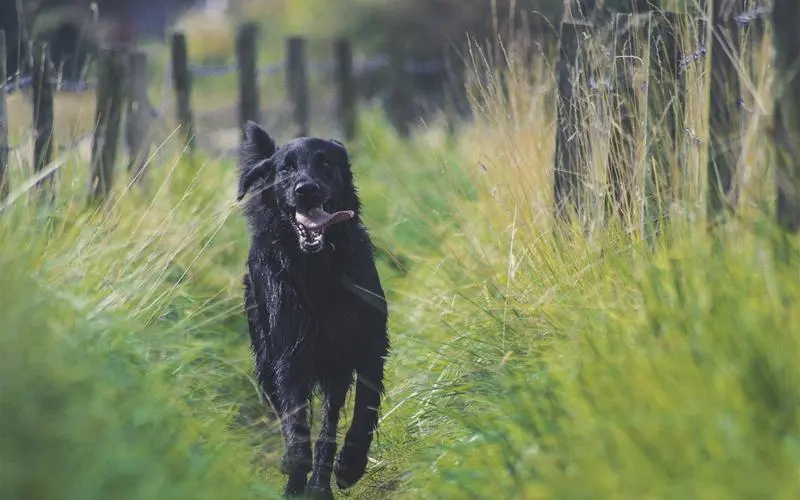The Lancashire heeler, a newly recognized breed by the American Kennel Club, has recently made its mark in the world of dog shows and competitions.
This small yet active breed, characterized by its distinctive “smile,” is poised to make a significant impact among the 200 other dog breeds vying for recognition and accolades.
With its compact size, resilient build, and characteristic black and tan coat, the Lancashire heeler bears a striking resemblance to a downsized corgi.
Standing at approximately 1 foot (30 centimeters) at the shoulder and weighing up to 17 pounds (7.7 kilograms), these dogs have historically served as invaluable farm assistants, adept at herding cattle and eliminating vermin.
Today, they continue to demonstrate their versatility and prowess in a wide range of canine activities and sports.
Patricia Blankenship, a seasoned breeder from Flora, Mississippi, attests to the Lancashire heeler’s remarkable traits, describing them as “gritty” and “intelligent” companions.
With over a decade of experience in breeding this breed, she emphasizes the sheer joy of being in the company of these remarkable dogs.
The recognition of the Lancashire heeler by the American Kennel Club opens up a world of opportunities for this breed, allowing them to participate in various prestigious dog shows, including the esteemed Westminster Kennel Club show.
This newfound recognition not only showcases the breed’s unique attributes but also underscores its potential to captivate the hearts of dog enthusiasts and judges alike.
As the Lancashire heeler steps into the spotlight, it brings with it a rich history of agricultural service and a contemporary spirit of agility and adaptability.
Its inclusion in the realm of competitive dog shows not only elevates its status but also sheds light on the diverse and remarkable world of canine companionship.
In conclusion, the recognition of the Lancashire heeler by the American Kennel Club heralds a new chapter for this exceptional breed.
With its distinctive characteristics, unwavering spirit, and proven capabilities, the Lancashire heeler is poised to carve out a distinct niche in the world of dog shows and competitions.
As it competes alongside 200 other breeds, the Lancashire heeler stands as a testament to the enduring bond between humans and their faithful canine companions.
In the vast and diverse world of dog breeds, the Lancashire Heeler stands out as a remarkable and versatile companion.
Its official breed standard, often referred to as the breed description or standard in the dog community, highlights its key traits: courage, happiness, and affection toward its owner.
Indeed, owners of this breed often speak of their contented heelers exhibiting a delightful “smile,” a heartwarming expression of their joy and contentment.
President of the United States Lancashire Heeler Club, Sheryl Bradbury, emphasizes the breed’s exceptional versatility.
Lancashire Heelers are known for their participation in a wide range of activities, from scent work to engaging in competitive dock diving contests.
Bradbury further underscores the importance of the Lancashire Heeler having a purpose or “job.” Whether it involves participating in organized dog sports or simply enjoying walks and games of fetch with its owners, this breed thrives when it has a meaningful role to fulfill.
According to Bradbury, Lancashire Heelers greatly benefit from interacting with a variety of people and other canines.
This socialization is crucial for their overall well-being and development. As a breeder based in Plattsmouth, Nebraska, Bradbury’s insights into the breed’s needs and characteristics offer valuable guidance to those who seek to understand and care for these remarkable dogs.
The Lancashire Heeler’s reputation for courage, happiness, and loyalty is well-deserved. Their unwavering affection toward their owners and their eagerness to engage in various activities make them a cherished and integral part of many households.
Their adaptability and willingness to participate in diverse pursuits, from competitive events to everyday activities, exemplify their remarkable versatility.
The Lancashire Heeler’s need for a sense of purpose serves as a testament to their intelligence and innate drive.

This breed’s desire to be actively engaged in meaningful activities underscores the importance of understanding and meeting their unique needs.
Whether it involves structured training, organized sports, or daily exercise, providing Lancashire Heelers with a fulfilling lifestyle is essential for their overall well-being and happiness.
In conclusion, the Lancashire Heeler embodies the qualities of a courageous, happy, and affectionate companion.
Their versatility and eagerness to participate in various activities make them a truly exceptional breed. Understanding their need for purpose and socialization is key to ensuring their happiness and fulfillment.
As cherished members of countless households, Lancashire Heelers continue to captivate the hearts of dog lovers around the world, leaving an indelible mark as loyal and versatile companions.
The Lancashire Heeler, a breed with deep roots in the United Kingdom, faces a precarious future as it is categorized as a “vulnerable native breed” at risk of extinction in its country of origin.
The Kennel Club of Britain has recorded an average of merely 121 new Lancashire Heelers annually, while the American Kennel Club estimates that there are only around 5,000 of these dogs worldwide.
Established in 1884, the American Kennel Club (AKC) stands as the oldest purebred dog registry in the United States.
It serves as a governing body for a wide array of canine competitions, encompassing events open to both mixed-breeds and purebreds.
However, only the 201 recognized breeds are eligible to compete for the prestigious “best in show” accolades at renowned events such as Westminster.
For a breed to attain recognition, it must boast a minimum of 300 pedigreed dogs spread across at least 20 states, and enthusiasts must reach a consensus on the breed’s standard.
Recognition is a voluntary process, and some breed enthusiasts may opt to seek recognition from other kennel clubs or forego the process entirely.
The addition of new breeds, or the perpetuation of existing ones, has stirred controversy among animal rights activists.

They argue that dog breeding fuels the operations of puppy mills, diminishes the number of pet adoptions, and exacerbates health issues in canines by limiting genetic diversity.
In response to these concerns, the AKC asserts that it advocates for responsible breeding practices aimed at producing dogs with specific abilities, such as tracking lost individuals, as well as pets with predictable and desirable traits.
The club has also contributed over $32 million since 1995 to a foundation that supports research into canine health.
The plight of the Lancashire Heeler serves as a poignant reminder of the complex interplay between breed preservation, ethical concerns surrounding dog breeding, and the pursuit of excellence in the world of purebred dogs.
As the debate continues, it is imperative to consider the welfare of these animals and the long-term sustainability of their breeds.
